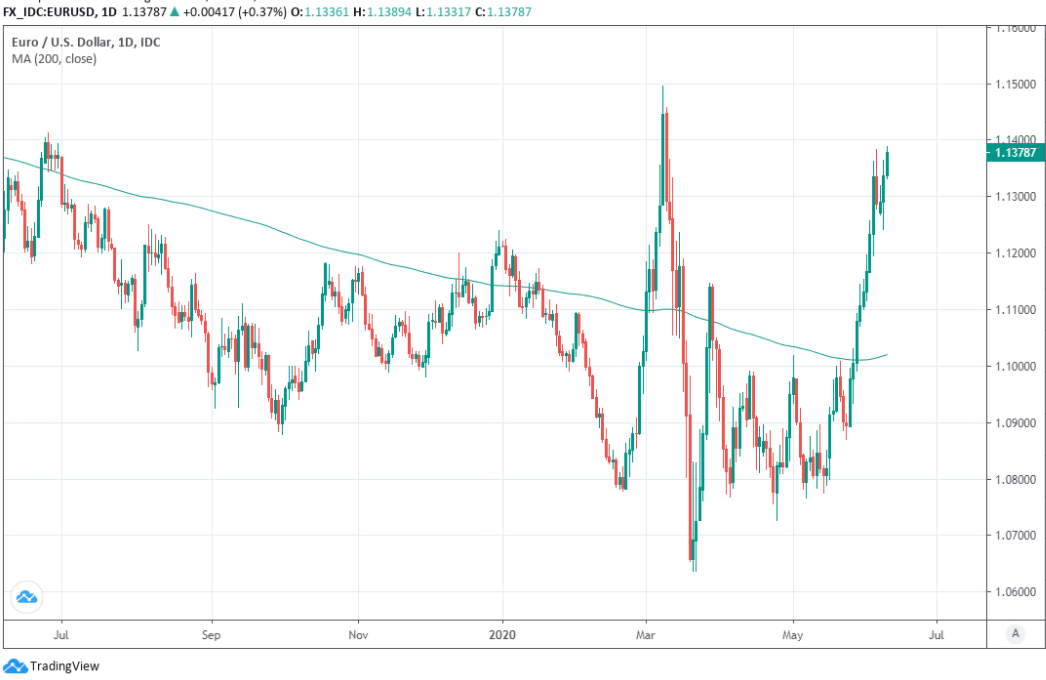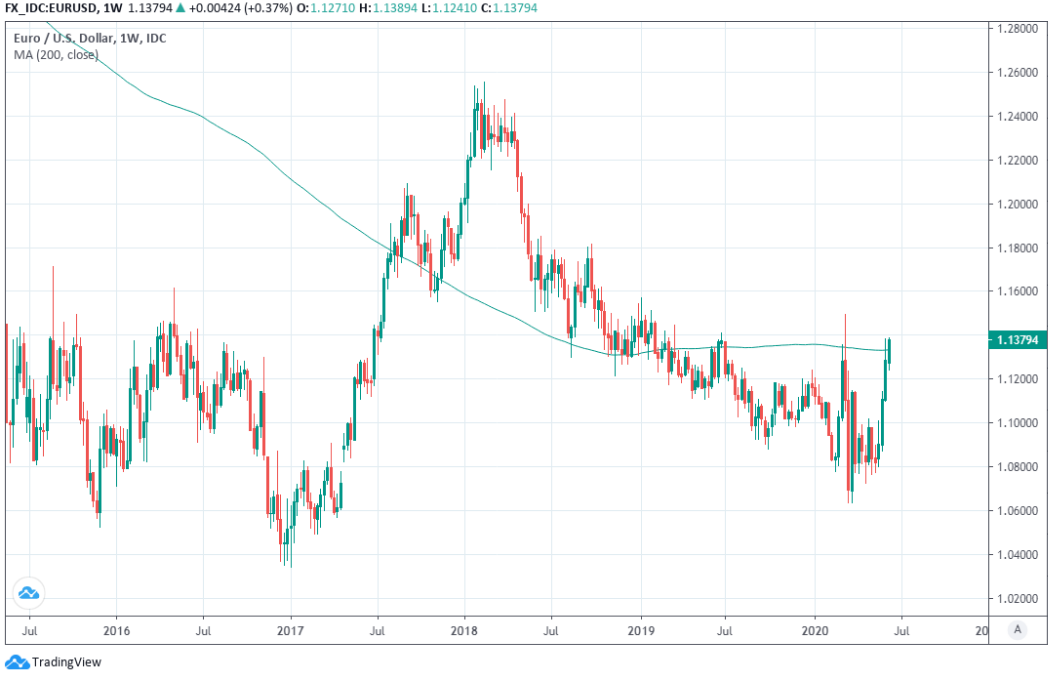Euro-to-Dollar Rate Climbs to Highest Since March as Rally Seen Enduring
- Written by: James Skinner
-
- EUR at highest since March on ECB speculation, ahead of Fed.
- ECB said to mull action on EZ bad loans in latest virus response.
- Analysts tip test of 1.15 as stocks, relative growth key to outlook.

Image © Adobe Images
Secure a retail exchange rate that is between 3-5% stronger than offered by leading banks, learn more.
The Euro climbed to its highest level against the Dollar since March on Wednesday amid speculation suggesting a European Central Bank (ECB) cleanup of the Eurozone banking sector could be in the pipeline, while the greenback continued a multi-week unravelling.
Europe's single currency climbed briefly to 1.1388 and its highest level since March 10 Wednesday after having risen back above its 200-week moving-average earlier in the session. Robust risk appetite and Dollar weakness ahead of the latest Federal Reserve (Fed) policy decision were among the factors driving price action although analysts also cited a Reuters report suggesting an ECB sponsored clean-up of the banking sector could be afoot.
Reuters reported the ECB is contemplating a 'bad bank' that would relieve commercial banks of soured coronavirus-related loans that might otherwise restrict lending to companies and households at a time when it's crucial more than ever for economies that credit continues to flow. Some Southern European countries already had problems with bad loans in their banking sectors that were inhibiting lending even before the coronavirus came along.
"At some point, you’re going to get a spike in NPL’s that the EZ needs to prep for. The above is an extension of ‘pooling the risk’ between countries, so you can expect some pushback," says Bipan Rai, North American head of FX strategy at CIBC Capital Markets, who's looking for the Euro to reach 1.15 in the coming weeks. "EUR/USD climbs higher likely due to weakness on the USD leg into the FOMC today. We like buying dips around the 1.1250 area." 
Above: Euro-to-Dollar rate shown at daily intervals with 200-day moving-average.
European regulators had worked for years to reduce a the mountains of bad loans that built up in some countries following the debt crisis, which saw Italy's non-performing loan ratio cut by half in the three years to 2020 but the coronavirus and damage resulting from measures used to contain it risks undoing that progress without action. The proposals reported by Reuters are the latest to suggest a powerful European policy response is coming together, although they'd be controversial in some parts of the EU.
"We are not at all inclined to fade the move higher in EURUSD yet, and we are conscious of the fact that global reflation and reserve accumulation cycles tend to stick around for a while. Today's FOMC has the potential to give that dynamic a "green light," says Stephen Gallo, European head of FX strategy at BMO Capital Markets. "Equities traded with a cautious tone ahead of the FOMC (Stoxx-50 -0.7%). But the USD continued to weaken."
The Euro has been lifted more than 5% against the Dollar since May 18 when France and Germany announced proposals for a coronavirus recovery fund that were quickly bulked up by the European Commission and put forward for discussion by member states. Plans for €750bn of centrally financed recovery spending from January 2021, combined with €1.35 trillion of bond buying from the ECB have been a game-changer for sentiment toward the Euro and instrumental in deflating the Dollar.
"The upcoming long-term EU budget for 2021 -2027, together with the EU Recovery Instrument (EUR 1.85tn in total ) and national fiscal expansions (e.g. Germany) could add to European debt and equity market optimism," says Richard Falkenhall, a senior FX strategist at SEB. "Equity flows, which tend less often to be currency hedged than fixed income investments, potentially have a large impact on the EUR/USD going forward. Continued improvement in risk appetite should attract money from safe dollar assets back into Europe."
Above: Euro-to-Dollar rate shown at weekly intervals with 200-week moving-average.
The push to collectively finance the coronavirus recovery has come alongside a move by Germany to loosen its own purse strings in a meaningful way, which has got an increasing share of the market favouring Europe over the U.S. when it comes to the relative economic outlook. All of this has bolstered the appeal of the Euro to analysts and investors at a time when robust risk appetites and Federal Reserve monetary policy is increasingly weighing on the Dollar.
"In the short term we have the March highs of 1.1450/1.15 in mind," says Jordan Rochester at Nomura. "The main question from clients has been on why the Euro area would necessarily outperform the US (i.e. the USD smile may argue for EUR strength to be contained). A month ago we would have agreed, the US is less dependent on the Banking sector, Global trade and travel/tourism than the Euro area and would be more inclined to bounce back. But there are several factors why EUR strength can continue despite this."
The Euro's gains have squeezed those who were previously wagering against it and compelled a wave of forecast upgrades while leaving a sizable portion of the market looking to the 1.15 handle as a likely short-term target. Global stock markets have advanced strongly of late, lifting risk-sensitive currencies while those in Europe have outperformed their counterparts in the U.S. and been cited for some of the recent gains in the Euro-to-Dollar rate. But much now depends on how investor risk appetites evolve as well as the relative pace of economic recovery between the U.S. and Europe.
"The EUR-USD recovery could pause in the coming months: Europe's bickering over the EU reconstruction fund and an initially rapid recovery of the US economy could for now overshadow the medium-term arguments. We therefore expect the EUR-USD exchange rate to trade around 1.14 by the end of the year and only in 2021 will it be able to rise to just below 1.20," says Ulrich Leuchtmann, head of FX strategy at Commerzbank.





